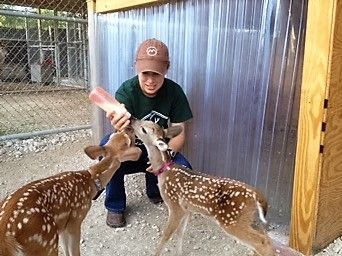
Growing Up in a Sauna - The Effects of Heat on White-tailed Deer Fawns

We are on the tail-end of summer. The 100 degree temperatures of July and August are fading behind expectations of cooler weather and the upcoming hunting season. Despite good fawn production in recent years, this year’s deer season will be influenced by the droughts of 2009 and 2011 because the low fawn crops of those years reduced the number of mature bucks in deer herds across Texas.
The common explanation for lower fawn crops during drought is that poor forage quality and poor fawn cover cause fawn survival to plummet. Supplemental feed increases fawn crops during drought, but does not entirely alleviate the drought effect. Similarly, predator control does not consistently increase fawn crops. These observations and others suggest that the intolerable heat that comes with drought may also influence fawn production.
The effect of heat on growth and production of domestic animals is widely recognized. Milk production of dairy cows and growth rate of steers decline as temperature increases. High temperatures decrease appetite, slow metabolism, and increase energy expenditure as animals contend with the heat. Despite the well documented effects of high temperatures on domestic species, there has been little research on the effects of hot summer temperatures on white-tailed deer fawns. Negative effects of heat are especially important in South Texas because most fawns are born in July and therefore spend the first 2 months of their life in the hottest temperatures experienced by white-tailed deer in any area across their vast range. To help us understand the effect of high temperatures on fawns, we conducted a study at the Alkek Captive Ungulate Facility in Kingsville.
Our methods involved raising 17 fawns born in our captive deer herd. We bottle-raised the fawns to standardize the amount and quality of milk each fawn received. We divided these fawns into 2 groups and raised them in pens with 6’ X 8’ X 4’ boxes where they could hide. The boxes in half the enclosures were air conditioned, allowing those fawns to escape the heat if they chose. The other half of the fawns lived in typical South Texas temperatures.
We found that the fawns in the cooler environment weighed 9% more at weaning and drank 4% more milk during the first 4 weeks of bottle-feeding. Although not statistically significant, fawns in the cooler environment ate 25% more solid feed. Finally, we measured stress hormones of the fawns monthly to gain some insight into the amount of stress experienced by the fawns. Increased stress can depress growth and reduce activity of immune system. Fawns in the cooler environment had 40% lower stress hormone concentrations than fawns in ambient temperature.
What do these results mean for managers? Our results show fawns are challenged by hot summer temperatures in South Texas. Furthermore, poor fawn production and small body sizes of fawns observed during drought cannot be fully alleviated by providing supplemental food. Thus, managers should not expect fawns to grow as fast as they would during cooler summers because high temperatures will limit fawn intake and increase stress. In the pasture, hot temperatures may have an even larger effect on fawn growth because milk production by the dam may be reduced.
So what is a manager to do? Obviously, installing air conditioning is not a viable management approach. Instead, managers should provide thermal cover in the form of brush for shade and ground cover to reduce the temperature of the soil. The heavy brush along drainages may be especially good during the heat of midday. Avoiding areas with good brush and ground cover during summer will make sure the deer are comfortable using such areas to contend with the sauna that is South Texas during summer.
This study was supported by The Stedman Fellowship for White-tailed Deer Research, the Albert and Margaret Alkek Foundation, and CKWRI Partner contributions to the CKWRI Deer Research Program. The input and support of Drs. Randy DeYoung and Michael Sheriff (Pennsylvania State University) are appreciated.